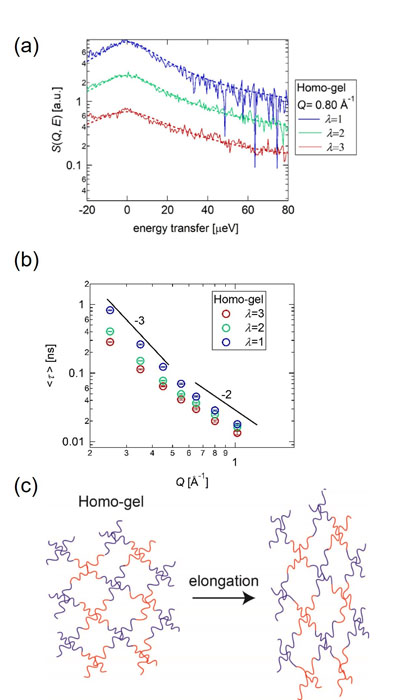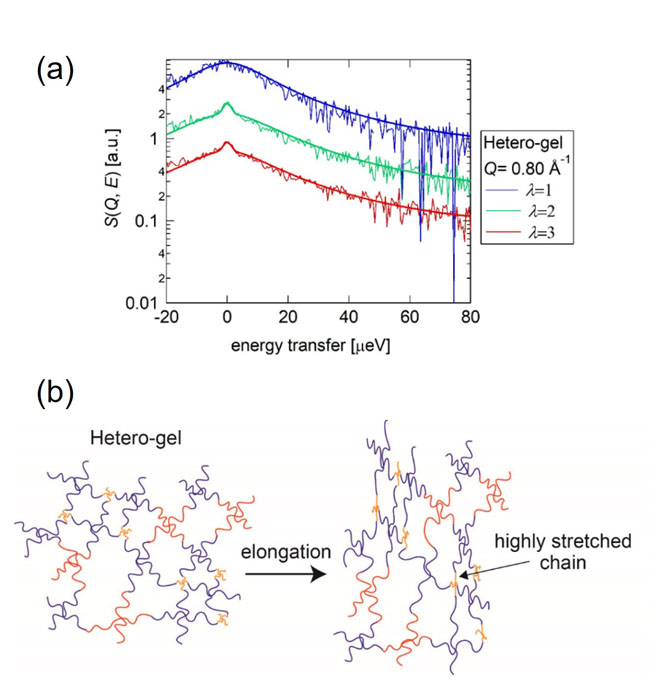Quasi-Elastic Neutron Scattering Study on Stretched Polymer Gels
Mayumi Group
Hydrogels, cross-linked polymer networks containing water, are expected to be applied for biomaterials and the mechanical toughness of polymer gels needs to be improved. The reason for the brittleness of polymer gels is the heterogeneous strain distribution caused by their inhomogeneous network structure. When a polymer gel is stretched, local stress concentrates on at short strands between cross-links. The stress-concentrated strands are highly stretched and become potential fracture onsets, which dominates the macroscopic fracture properties of polymer gels.
In this study, the segment/monomer dynamics of polymer gels under uniaxial deformation is investigated by means of quasi-elastic neutron scattering (QENS) [1]. In order to clarify the effect of heterogeneity in polymer network structure, we prepared two types of polymer gels with controlled heterogeneities: a homogeneous Tetra-PEG gel prepared by end-cross-linking of Tetra-arm prepolymers (Homo-gel) [2], and heterogeneous Tetra-PEG gel (Hetero-gel) containing a small amount of Tetra-PEG prepolymers with shorter arms [3]. Hetero-gel shows a more brittle fracture behavior than Homo-gel, which suggests a stress-concentration occurs in Hetero-gel under deformation.
Figures 1 (a) shows S(Q, ω) for Homo-gel under uniaxial deformation (λ = 1, 2, 3) at Q = 0.8 Å−1. The dynamic structure factors were fitted with a KWW function. As shown in Figure 1 (b), the average relaxation times (τ) of Homo-gel decrease with increasing stretching, and the segment/monomer dynamics in the gel are accelerated by stretching. Stretching exponent β for the homogeneous gel is not changed with stretching, suggesting that the local deformation in the gel is kept homogeneous (Fig. 1 (c)).
Figures 2 (a) shows S(Q, ω) of Hetero-gel under uniaxial deformation (λ = 1, 2, 3) at Q = 0.8 Å−1. A sharp elastic peak corresponding to slow chain dynamics with a broad base was observed under deformation (λ = 2, 3), while only a broad peak was seen for the un-deformed state (λ =1). This means that the slow chain dynamics appears only for the deformed Hetero-gel. The elastic component can be ascribed to a slow chain dynamics of highly stretched short strands (Fig. 2 (b)). When Hetero-gel is stretched, the short strands oriented to the stretching direction are strongly stretched and the chain dynamics of the highly deformed chains is suppressed, which causes a more brittle macroscopic fracture compared with that in the case of Homo-gel.
References
- [1] K. Aomura, Y. Yasuda, T. Yamada, T. Sakai, and K. Mayumi, Soft Matter, 19, 147 (2023).
- [2] T. Sakai, T. Matsunaga, Y. Yamamoto, C. Ito, R. Yoshida, S. Suzuki, N. Sasaki, M. Shibayama, and U. I. Chung, Macromolecules 41, 5379 (2008).
- [3] S. Kondo, H. Sakurai, U. I. Chung, and T. Sakai, Macromolecules 46, 7027 (2013).


